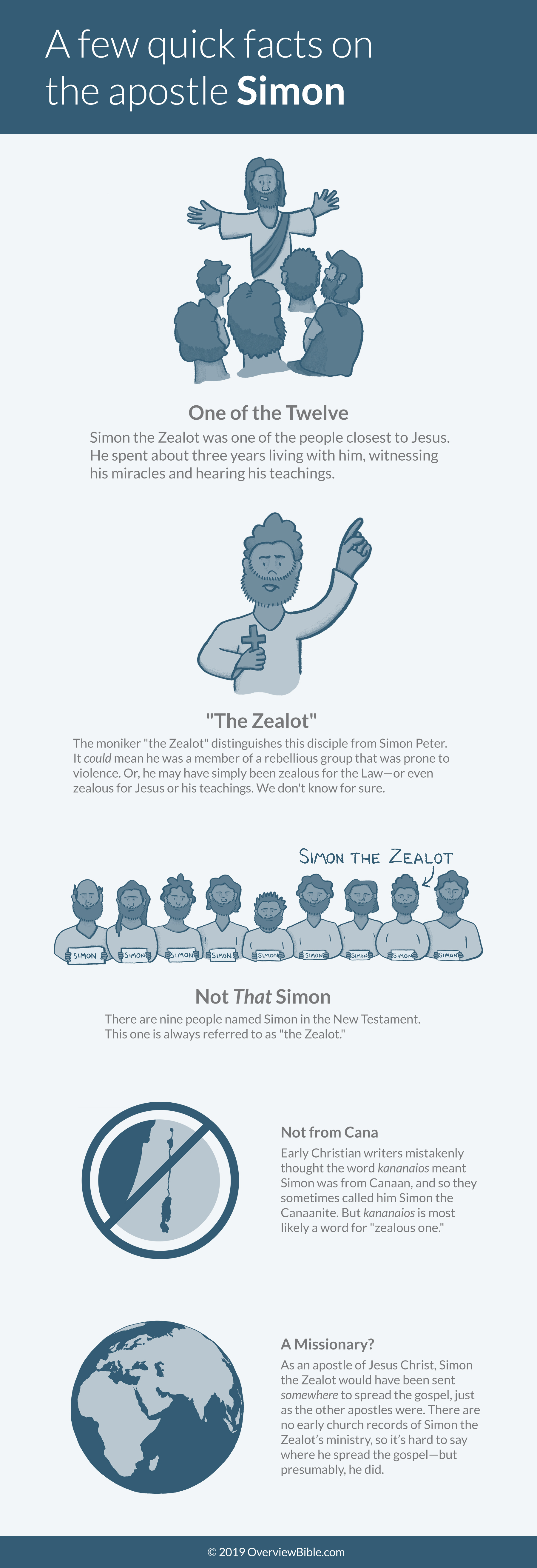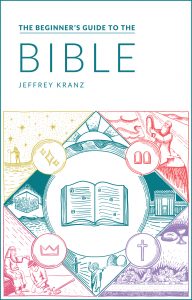Simon the Zealot is one of the most obscure apostles. He was one of the 12 main disciples of Jesus Christ, but he plays no particular role in the gospels and is only mentioned by name in lists of the apostles (Matthew 10:2-4, Mark 3:16-19, Luke 6:14-16, Acts 1:1-13).
We know almost nothing about Simon the Zealot. Even his moniker, “the Zealot” is ambiguous enough that we can’t be sure what it means—though there are several strong possibilities. He may have belonged to a Jewish sect known as the Zealots, who were bent on revolution and looking for a Messiah to violently overthrow Rome. Or he may have simply been zealous for the Mosaic Law. Or even zealous for Jesus and his teachings.
Simon is mentioned occasionally in early church writings, but centuries after the gospels were written, Saint Jerome and others mistranslated Simon’s title, believing that Matthew and Mark referred to him as Simon the Cananite or Simon the Cananaean. They assumed he was from Cana—a town within Galilee—or possibly Canaan, an ancient region in the near east which was frequently mentioned in the Bible. This mistake led to the idea that Simon was present at the wedding in Cana in John 2, where Jesus performed his first miracle and turned water into wine, and that he was the same person as Simon, the brother of Jesus (Matthew 13:55).
Some Bible translations preserve Jerome’s mistake out of respect for tradition, calling Simon “the Cananite” or “the Cananaean” in Matthew 10:3 and Mark 3:18.
So who was this person the Bible calls Simon the Zealot, and what do we actually know about him? In this guide, we’ll dig into the ambiguities surrounding this lesser-known biblical figure, address some common confusions, and look at how he may have died.
First, the facts.

Who was Simon the Zealot?
Since the Apostle Simon is only listed among the apostles (and he’s completely absent from the Gospel of John), there’s not much we can say about him. But here’s what we know.
One of the Twelve
The New Testament lists all twelve apostles four times—Matthew 10:2-4, Mark 3:14-19, Luke 6:13-16, and Acts 1:13-16. While there are some variations in the order the apostles appear and even the names they went by, Simon is listed in all of them. He’s never mentioned in the Gospel of John, but John never explicitly lists all the apostles.
This means Simon was one of the people who was closest to Jesus, and that he spent about three years living with him, witnessing his miracles, and hearing his teachings. He saw numerous demonstrations of Jesus’ divinity.
Even though the Book of Acts and the epistles never describe Simon the Zealot’s ministry, as one of the Twelve, he would’ve been one of the most important leaders of the early church.
“The Zealot”
The moniker “the Zealot” comes from the Greek word zēlōtēs, which the Apostle Luke used in both his gospel and Acts to distinguish this Simon from Simon Peter. Matthew and Mark give him the title kananaios, which most scholars believe comes from the Aramaic word qan’an, meaning “zealous one.”
So what does this title mean? It could mean he belonged to a Jewish sect known as the Zealots. The Zealots were associated with violent uprisings (including, later, the First Jewish-Roman War), and expected the coming Messiah to overthrow Rome using force.
If that’s what “the Zealot” refers to, then like Matthew the Tax Collector, the Apostle Simon’s presence among the Twelve represents a powerful picture of the gospel. Jesus’ teachings (such as turning the other cheek and loving your enemies) were often the complete opposite of the ideology the Zealots embraced. Although it’s worth noting, in the Talmud, Jewish rabbis advocated for peace as well, and the Zealots ignored them.
But the group known as “the Zealots” may not have existed at the time the gospels took place—possibly not even when they were written. In The Anchor Yale Bible Dictionary, New Testament Scholar David Rhoades says:
“The evidence from Josephus suggests that it was not until about 68 C.E. during the Roman-Judean War that one of the revolutionary factions came to identify itself formally as the Zealots. Therefore, it is anachronistic to view people acting with zeal before 68 C.E. as members of a sect called the Zealots.”
Besides, zealousness is a quality that frequently comes up in Scripture, so it could have easily been a description of a positive quality Simon possessed, rather than a sect he belonged to—especially if that group wasn’t known by that name at the time.
Professor Rhoades explains it this way:
“Zeal is behavior motivated by the jealous desire to protect one’s self, group, space, or time against violations. In the biblical tradition, human acts of zeal punished idolatrous violations of God’s right to exclusive allegiance from Israel. As expressed in the First Commandment, God is a jealous/zealous God who requires the allegiance of the people. Because God’s holiness will not tolerate idolatry or other violations against the covenant (Exod 20:5; Deut 5:9), God will punish the whole nation for such offenses unless someone acts on behalf of God—zealous with God’s jealous anger—to kill or root out the offenders.”
When Jesus cleanses the temple in the Gospel of John, his disciples recall Psalm 69:10, implying that Jesus was motivated by zeal:
“His disciples remembered that it is written: ‘Zeal for your house will consume me.’”
The Apostle Paul talks about his own zeal and the zeal of the Israelites on multiple occasions (Philippians 3:6, Galatians 1:13-14, Acts 22:3, and Romans 10:1-4). On Paul’s third missionary journey, Jews and Jewish Christians who were “zealous for the Law” wanted to kill Paul (Acts 21:20; 23:12–14).
Rhoades concludes that the term “zealot” is ambiguous enough for there to be more than one valid interpretation:
“Some scholars assume that citations to zeal and zealots in the 1st century, such as the NT references to Simon the zealot, refer to a Jewish sect of Zealots dedicated to revolution against Rome. Other scholars disagree. The failure in ancient manuscripts to distinguish formal nouns allows for differing interpretations regarding the use of the term ‘zealot.’ It seems clear, however, that Jewish and Christian writings of the period refer to a wide variety of offenses against which private individuals or groups might act in zeal on behalf of the community, some of these actions being revolutionary and others not.”
Simon may have been a member of a rebellious group that was prone to violence. Or, he may have simply been zealous for the Law—or even zealous for Jesus or his teachings. In any case, the gospel writers used this description to distinguish this Simon from Simon Peter—and the other Simons in the New Testament.
Not that Simon
There are nine people named Simon in the New Testament. Two of them are among Jesus’ Twelve Apostles—Simon the Zealot and Simon Peter.
- Judas Iscariot is the son of Simon Iscariot (John 6:71).
- Simon is the name of one of Jesus’ brothers (Mark 6:3), who’s traditionally believed to have succeeded James as head of the church in Jerusalem.
- A Pharisee named Simon invited Jesus over for dinner, where a sinful woman famously poured perfume on Jesus’ feet (Luke 7:40).
- Simon the Leper hosts Jesus for dinner in Bethany (Mark 14:3).
- When Jesus was carrying his cross on his way to be crucified, a man named Simon from Cyrene was forced to help him (Mark 15:21).
- In Acts, a man known as Simon the Sorceror attempted to buy the power of the Holy Spirit from Peter (Acts 8:9-24).
- When Peter had his vision of unclean food, he was staying at Simon the Tanner’s house (Acts 9:43).
Each of these Simons is clearly distinct, and Simon the Apostle is always referred to with the moniker “the Zealot.”
Not from Cana
In his commentary on Matthew, Jerome mistakenly interpreted kananaios as an indicator that Simon was from Cana, which led to other errors:
“He was surnamed Peter to distinguish him from another Simon who is called the Cananean, from the village of Cana of Galilee, where the Lord turned water into wine.”
Other church fathers made this error as well, and it was perpetuated throughout church tradition for so long that some modern translations still say, “Simon the Cananite” or “Simon the Cananean” in Matthew 10:3 and Mark 3:18.
In the thirteenth century, Jacobus de Varagine compiled numerous biographies of the saints into The Golden Legend, where centuries after Jerome, the error was repeated:
“Simon is as much to say as obedient, or being in heaviness. And he had a double name; he was said Simon Zelotes, and Simon Cananean of Cana a street that is in Galilee, there whereas our Lord converted the water into wine.”
More than 1,000 copies of The Golden Legend survive today, showing how deeply embedded this mistranslation was in the church.
Most scholars today believe kananaios comes from the Aramaic word qan’an, meaning “zealous one,” which effectively makes Simon’s moniker the same in Matthew, Mark, Luke, and Acts.
A missionary?
As an apostle of Jesus Christ, Simon the Zealot would have been sent somewhere to spread the gospel, just as the other apostles were. The word we translate as apostle (apóstolos) literally means “one who is sent.”
The Golden Legend records that Simon preached in Egypt, then partnered with Judas, the brother of Jesus:
“Judas preached first in Mesopotamia and in Pontus, and Simon preached in Egypt, and from thence came they into Persia, and found there two enchanters, Zaroes and Arphaxat, whom S. Matthew had driven out of Ethiopia.”
There are no early church records of Simon the Zealot’s ministry, so it’s hard to say where he spread the gospel—but presumably, he did.
Who were “the Zealots” in the Bible?
Since Simon is commonly identified with the Jewish sect known as the Zealots, it’s worth unpacking who they were. It’s unclear when the group formally became known as the Zealots.
Our most detailed descriptions of who they were, how their movement started, and what they stood for comes from Flavius Josephus, a Jewish-Roman historian who lived during the first century.
Josephus fought against the Romans in the First Jewish-Roman War. When he surrendered to Vespasian, he claimed Jewish messianic prophecies were about Vespasian becoming the emperor of Rome, and lo and behold Vespasian decided to let him live, taking him on as a slave. Vespasian became emperor and granted Josephus Roman citizenship.
Some scholars believe Josephus exaggerated the Zealots to keep the peace, blaming the war on a small Jewish sect and some bad Roman leaders. As we mentioned earlier, Rhoades argues that Josephus’ work makes it clear that there was no formal group called the Zealots until about 68 AD.
However, Josephus attempted to trace the group’s origins back to a small uprising by a man named Judas of Galilee, who stirred up a rebellion due to a Roman census in 6 AD—the very same Roman census which Luke says led Mary and Joseph to Nazareth, where Jesus was born.
Here’s how Josephus explains it in The Antiquities of the Jews:
“Yet was there one Judas, a Gaulonite; of a city whose name was Gamala; who, taking with him Saddouk, a Pharisee, became zealous to draw them to a revolt: who both said that this taxation was no better than an introduction to slavery: and exhorted the nation to assert their liberty.”
Professor David Rhoades elaborates in The Anchor Yale Bible Dictionary:
“Judas and his followers opposed Jews who cooperated with the census, for they considered cooperation with Caesar to be an idolatrous transgression of the First Commandment to have ‘no other lords before me.’ Judas’ small and unsuccessful revolt was carried out in the belief that if the Jews were faithful to the covenant, God would honor their cause by bringing victory in the struggle against Rome. Judas was apparently killed as a result of his actions.”
Josephus identifies three main Jewish sects—the Essenes, the Saduccees, and the Pharisees. He suggests that the Zealots were a fourth which sprung up as a result of Judas’ influence and caused the problems which led to the First Jewish-Roman War:
“For Judas and Sadducus, who excited a fourth philosophick sect among us, and had a great many followers therein, filled our civil government with tumults at present, and laid the foundations of our future miseries, by this system of philosophy, which we before were unacquainted withal.”
Here’s how Josephus described the “Fourth Philosophy” which became known as the Zealots:
“These men agree in all other things with the Pharisaic notions; but they have an inviolable attachment to liberty, and say that God is to be their only Ruler and Lord. They also do not value dying any kinds of death, nor indeed do they heed the deaths of their relations and friends, nor can any such fear make them call any man lord. And since this immovable resolution of theirs is well known to a great many, I shall speak no further about that matter; nor am I afraid that any thing I have said of them should be disbelieved, but rather fear, that what I have said is beneath the resolution they show when they undergo pain. And it was in Gessius Florus’s time that the nation began to grow mad with this distemper, who was our procurator, and who occasioned the Jews to go wild with it by the abuse of his authority, and to make them revolt from the Romans.”
If Josephus’ account is reliable, it’s possible that Simon the Zealot did belong to this group—whether or not it was formally known as “the Zealots” at the time he was involved or the time the gospels were written.
The group formally known as the Zealots had strong associations with inciting rebellion out of a sense of liberty and patriotism. But it’s unclear when exactly this group started going by this name. It’s also unclear whether they were a serious threat, or just convenient scapegoats.
How did Simon the Zealot die?
There are numerous accounts of Simon the Zealot’s death, but the earliest records come centuries after his death. Like many of the apostles, it’s hard to conclude exactly which tradition (if any) can be trusted:
- In the fifth century, Moses of Chorene wrote that Simon the Zealot was martyred in the Kingdom of Iberia.
- The Golden Legend says he was martyred in Persia in 65 AD.
- Ethiopian Christians believe he was crucified in Samaria.
- Another account says he was crucified in 61 AD in Britain.
- In the sixteenth century, Justus Lipsius claimed he was sawed in half.
- Eastern tradition claims he died of old age in Edessa.
So maybe he was a martyr. And maybe not.
The zealous apostle
Like many of the lesser-known apostles, most of Simon the Zealot’s life and identity remains a mystery, and the few details the Bible gives us has led to centuries of speculation, little of which can be confirmed or denied.
But what we do know is this: he passionately believed in . . . something. Liberty, the Law, and/or the Lord. And Jesus saw in him the potential to spread the kingdom of heaven throughout the earth, not by force, but with the revolutionary power of love.




